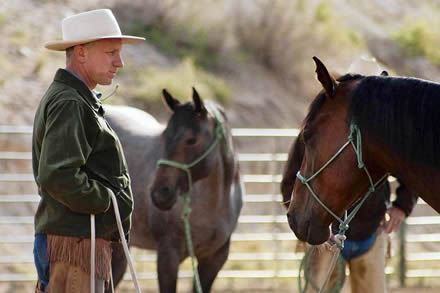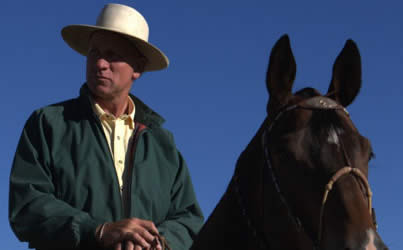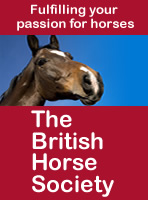
And photographs, if you have any.
Horseytalk.net Special Interview
Buck Brannaman
The man who was the inspiration for "The Horse Whisperer"
 Several years ago, I spent time with Gunther Gebel-Williams,
the celebrated Ringling Bros. and Barnum & Bailey animal
trainer. I watched in awe as this intensely charismatic
man played with a cage full of lions and tigers as if they
were so many household cats. His assistant, standing next
to me, took it all in. “Both people and animals,” he
explained, “they want his good word.
Several years ago, I spent time with Gunther Gebel-Williams,
the celebrated Ringling Bros. and Barnum & Bailey animal
trainer. I watched in awe as this intensely charismatic
man played with a cage full of lions and tigers as if they
were so many household cats. His assistant, standing next
to me, took it all in. “Both people and animals,” he
explained, “they want his good word.
”As it was with Gebel-Williams, so it is with Buck Brannaman, the subject of the marvelous new documentary “Buck.” The acknowledged inspiration for “The Horse Whisperer” (author Nicholas Evans calls him “the Zen master of the horse world”), Brannaman overcame a horrific childhood to do things with horses that beggar description.
Perhaps the most prominent advocate of what is known as natural horsemanship, Brannaman likes to say that though he’s hired to help with a person’s horse problems, he ends up dealing with a horse’s people problems.
His goal is to ease the path between owner and horse, to look at situations from the horse’s point of view and “make the wrong thing difficult and the right thing easy.”
Sitting down for an interview in Park City, where “Buck” won the documentary competition audience award at this year’s Sundance Film Festival, the calm, centered 49-year-old Brannaman has the empathy and insight of a world-class therapist; he just happens to work with horses. As with Gebel-Williams, personal qualities are a key to his success: People and animals really do seek out his good word.
In fact, the reason that “Buck” the film exists is that first-time director Cindy Meehl, a fashion designer who met Brannaman at a clinic eight years ago, was so taken by his qualities that she took up filmmaking just to tell his story.
“I was so blown away by him,” Meehl says. “I’d gone my whole life being taught a different way. I’d had hundreds, maybe thousands of lessons, and no one had come close to his methods.”
Some of those qualities come from surviving an especially grim and abusive childhood. Brannaman’s father not only relentlessly molded Buck and his brother into boy roping stars known as the Idaho Cowboys, Buckshot and Smokie, but he also so regularly beat them with whips, belts and whatever was handy that they were taken away from him by court order and placed with foster parents Betsy and Forrest Shirley.
Asked why he turned out so well despite this kind of a past, Brannaman remembers back to his first summer with the Shirleys and a moment of quiet reflection on top of a stack of hay bales.
“I was smart enough to realize that what I’d gone through gave me a free pass for a lot of really bad behavior. I thought, ‘Everyone feels really terrible about what happened to you, but you have to reject all that sympathy and go forward.’ Everyone reaches a point in life where you have a choice to go one way or another. I no longer wanted to blame it on everyone else. I wanted to take responsibility.”
Brannaman was considering working as a cowboy after high school, and one day he wandered into a clinic led by a man named Ray Hunt and Hunt’s mentor, Tom Dorrance, a clinic that changed his life. Dorrance, who died in 2003, is thought of as the founder of the modern natural horsemanship movement, and Brannaman is still in awe of the man and what he accomplished.
“His family had a small ranch near Joseph, (Ore.,) and as a little boy, it troubled him how adults worked with horses,” Brannaman says. “So, he devoted his life to trying to find a better way, as if the horse got to help make up the rules. He was such a humble, understated man, he was able to study the horse without letting ego and emotions get into it.”
One of the things that helped Dorrance, Brannaman says, was a phenomenal memory. “I saw someone come up and introduce herself to him and Tom said, ‘I know who you are.’ The woman said, ‘But we’ve never met,’ and Tom said, ‘I didn’t say that.’”
It turns out that decades earlier, Tom had the TV on in a bunkhouse and out of the corner of his eye had seen the woman “riding in the 1969 Miss College Rodeo competition. ‘You were riding a gray horse,’ he told her, ‘and you had a hard time getting the right lead on it.’ He knew every detail on that horse, he’d seen it and it went into a computer. If he was like that with more or less useless information, you can imagine how it was when stuff was important to him.”
 Dorrance’s ideas, Brannaman says, “troubled
a lot of people who’d been making war on horses.” And
because he was a quiet, subtle man, not big on explanations,
people saw the results he got with difficult animals and “thought
he was like a witch doctor.” It fell to Hunt, Dorrance’s
pupil, to bring his ideas to a wider audience. “If
not for Ray Hunt,” Brannaman says, “the world
would never have known.”
Dorrance’s ideas, Brannaman says, “troubled
a lot of people who’d been making war on horses.” And
because he was a quiet, subtle man, not big on explanations,
people saw the results he got with difficult animals and “thought
he was like a witch doctor.” It fell to Hunt, Dorrance’s
pupil, to bring his ideas to a wider audience. “If
not for Ray Hunt,” Brannaman says, “the world
would never have known.”
Brannaman became Hunt’s pupil the way the older man had been Dorrance’s and still remembers how hard it was to get his head around Hunt’s radical new teachings.
“I was young and physical and I wanted him to tell me to work harder,” Brannaman remembers. “Instead, he’d say things like, ‘You need to do less sooner,’ and I would look at him like a puppy that had heard a strange sound. It was all about not imposing my will on the horse. Ray would tell me, ‘Fix it up and let it happen; don’t make it happen.’ If I heard that once, I heard that a million times.”
Brannaman, who is called in to deal with horses that are acting badly, worries that in severe cases, the animal’s owner will not be able to do what he is able to do. In “Buck,” we see him handle a horse so disturbed that it attacks people just to be attacking.
“When I run across a really troubled horse, I hope the person who takes over from me has the aptitude to follow through,” he says. “Working with that kind of horse is the big leagues, there is no margin for error. Sometimes, people are so far in over their heads, I have to tell them, ‘You’re going to get hurt or get killed.’ I have a moral responsibility to tell them, ‘This horse isn’t going to fit you.’”
Essentially a one-man operation based at his ranch near Sheridan, Wyo., Brannaman is now so in demand around the world that he travels to clinics and consultations almost every week of the year. Yet his passion for his work, for seeing things the horse’s way, is undiminished.
“When a horse has a breakthrough, you’d think I’d be so used to it by now,” he relates. “But when it happens, it’s all I can do not to break down and cry right in front of everybody.”







